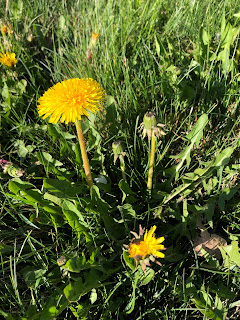 |
| Taraxacum officinale |
The flowers, on the other hand, are much better tasting, mild and with a flavor which can almost be called slightly sweet. I used the flowers to make dandelion fritters, which are a classic way to cook dandelions. Simply dip the fresh flowers in batter, and fry in oil. Most of my family described the taste as sweet, while people at work that I shared them with called them bitter, but those people are not used to wild foods.
The flowers usually close at night, and open when the sunlight hits them in the morning. So the best time to collect the flowers is in the morning, about an hour or two after dawn, when the flowers are at their freshest and fully open. They should be used as soon as possible, since they will begin to wilt, and will even go to seed if left for a day or two.
 |
| Dandelion flower fritters |
I tried a couple different batters. One was half wheat flour and half cornmeal, with enough water to make a thin, runny batter. This resulted in a nice crunchy flower fritter. I also tried a tempura style batter, with equal parts wheat flour and cornstarch in an egg and water base. This results in a smoother fritter, crisp when fresh, but getting softer after a while, which is typical of tempura. The taste was good in both cases, but I preferred the crunchy texture of the cornmeal batter.
The unopened flower buds are also good, and make a nice vegetable to add to stir-fries and similar dishes. For this, make sure the buds are tightly closed at the end. If there is yellow or white poking out the end, they have already opened. They are more difficult to collect than the flowers, because they are small, green, and often still nestled in the base of the leaves. The bright yellow flowers stick up and are very obvious.
As I mentioned before, the leaves are plentiful, common, and easy to identify, because they usually have flowers or seed clusters above them. But they are bitter, so I don't enjoy eating them much. The white bases are a little less bitter, so you can pull up the whole plant, wash the dirt off, and just eat the white center of the leaf rosette.
No comments:
Post a Comment